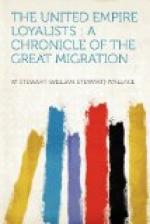When it is remembered that all this had been already done, it will be admitted to be a proof of the generosity of the British government that the total of the claims allowed by the royal commission amounted to 3,112,455 pounds.
The grants varied in size from 10 pounds, the compensation paid to a common soldier, to 44,500 pounds, the amount paid to Sir John Johnson. The total outlay on the part of Great Britain, both during and after the war, on account of the Loyalists, must have amounted to not less than 6,000,000 pounds, exclusive of the value of the lands assigned.
With the object possibly of assuaging the grievances of which the Loyalists complained in connection with the proceedings of the royal commission, Lord Dorchester (as Sir Guy Carleton was by that time styled) proposed in 1789 ’to put a Marke of Honor upon the families who had adhered to the unity of the empire, and joined the Royal Standard in America before the Treaty of Separation in the year 1783.’ It was therefore resolved that all Loyalists of that description were ’to be distinguished by the letters U. E. affixed to their names, alluding to their great principle, the unity of the empire.’ The land boards were ordered to preserve a registry of all such persons, ’to the end that their posterity may be discriminated from future settlers,’ and that their sons and daughters, on coming of age, might receive grants of two hundred acre lots. Unfortunately, the land boards carried out these instructions in a very half-hearted manner, and when Colonel John Graves Simcoe became lieutenant-governor of Upper Canada, he found the regulation a dead letter. He therefore revived it in a proclamation issued at York (now Toronto), on April 6, 1796, which directed the magistrates to ascertain under oath and to register the names of all those who by reason of their loyalty to the Empire were entitled to special distinction and grants of land. A list was compiled from the land board registers, from the provision lists and muster lists, and from the registrations made upon oath, which was known as the ‘Old U. E. List’; and it is a fact often forgotten that no one, the names of some of whose ancestors are not inscribed in that list, has the right to describe himself as a United Empire Loyalist.




